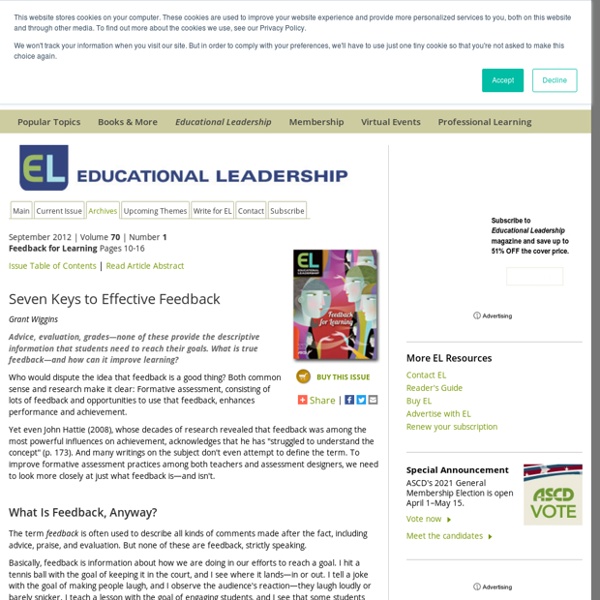Helping Shy Students
All teachers have had shy students in their classroom. These children are the ones who keep to themselves and quietly complete their work, often hiding from the attention of the teacher or their classmates. However, some of these children are not just shy or quiet but may have social anxiety disorder.
DIRTy Work
Excuse the cheap pun of a title. With all the public furore about the Daily Mail I couldn’t help but be mindful of a tabloid headline! DIRT, if you didn’t know, is an acronym. Apologies if you are tired of acronyms, but admit it, sometimes they are just plain useful. DIRT stands for ‘Dedicated Improvement and Reflection Time‘. It has become a useful short-hand for checking, drafting, proof reading and for labelling the age-old process of students spending crucial time on improving their work.
Effective Feedback for Deeper Learning
Dr. Natalie Saaris We’re trained to believe that feedback is generally a good thing. It’s crucial in helping us develop new skills and in scenarios where we cannot assess our own performance. In fact, feedback ranks in the top 5-10 highest influences on student achievement, which explains why it’s a foundation of learning from the earliest grades when students compete for teacher praise or gold star stickers. The more feedback the better, right?
Decoupling summative and formative assessment
The following post is my seminar notes from a session I ran with Christine Counsell on why ‘summative’ and ‘formative’ assessment need to be decoupled, particularly in terms of not principally using summative marking criteria to inform teaching. I am particularly grateful to the history teaching community (particularly the so-called ‘History Pizza Assessment Group’ in Cambridge) and Daisy Christodoulou for helping me clear up my thinking on this matter. The current prevailing model in formative assessment is to give pupils a task (an essay, an exam question, a piece of music to play) and then to judge their competence at that task using a series of levels, often based on either task-specific or generic descriptions of competence. Having ascertained how well a pupil performed on that task, we then identify what was absent from the performance: what should have been done that was not, or what could have been done better?
EfratFurst - Meaning First
Making meaning in explicit ways is crucial yet insufficient. Effective practice is essential to make the concept accessible and useful. Thanks to cognitive research we know a lot about designing effective practice. When it comes to semantic knowledge, effortful and deliberate retrieval practice that is adequately repeated, varied and distributed is highly beneficial for long-term learning7.
Johns Hopkins University: New Horizons for Learning
Welcome to New Horizons for Learning - a leading web resource for identifying and communicating successful strategies for educational practice. The Johns Hopkins School of Education does not vet or endorse any information contained on the New Horizons website. Information posted on New Horizons prior to January 1, 2014 can be repurposed as long as the repurposing party provides attribution to the original author of the material being used. Information posted on New Horizons after January 1, 2014 is considered open access information and can be repurposed without attribution to the original author.
Using DIRT as a Learning Journey
Education is full of acronyms. Some are useless, whilst others are impressive and useful. One such acronym which keeps popping up in the #UKEdChat community is DIRT, which stands for ‘Dedicated Improvement and Reflection Time‘, mainly aimed at secondary aged pupils (11+), although some aspects are already embedded within primary practice.
Feedback in schools by John Hattie
Feedback is one of the top 10 influences on student achievement. John Hattie’s research has focused on feedback for a long time. In 2011 John Hattie contributed to a publication by Sutton, Hornsey & Douglas about Feedback: The communication of praise, criticism, and advice with an article about ‘Feedback in schools’. This short text is definitely a must-read for everybody trying to learn more about the feedback model behind the Visible Learning research.
Getting Better at Feedback
The last few weeks have seen us progress through each of our Cornerstones of Teaching & Learning at The Sheffield College with drop-ins from the Digital and e-Learning team, links to browse via our Twitter feed and a blog each week for staff to reflect on – So in the fourth and final week, our attention turns to feedback. As I spent some time reviewing and gathering links related to feedback, I realised that if I let it, it could easily fill my entire week. This page contains the best of the links I came across-
23 Maker Learning Reflection Questions For Thoughtful Students
23 Maker Learning Reflection Questions For Thoughtful Students by Dr. Jackie Gerstein & TeachThought Staff Grow with TeachThought PD Maker Ed Workshops.
Differentiating Instruction
Within the four ways for differentiating instruction there are embedded several other learning strategies which are used in conjunction with each other. The Strategies: Readiness / Ability
How Rubrics Provide Feedback
I’d like to start with an assumption about rubrics. I believe that rubrics are tools designed to serve two purposes:They help a teacher assess student work consistently and clearly.They help provide feedback to students through setting expectations and evaluating performance.With these two goals in mind—assessment and feedback—I’d like to examine how rubrics need to be built and used to be able to serve those purposes. I recently wrote about the different kinds of rubrics, and I’d like to focus exclusively on analytic (rather than holistic) rubrics in this discussion. I’ve seen a number of assignment rubrics that are poorly designed and poorly implemented, and I’d like to point out the trouble with a particular approach and show how it can be fixed. First, though, I need to clarify a critical term.



